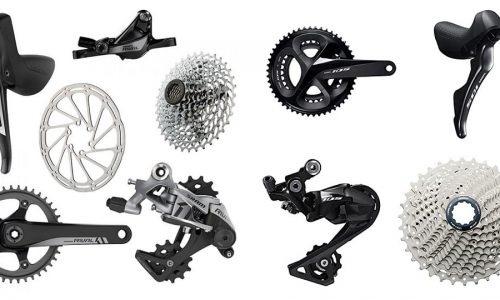Introduction
 If you’re thinking of buying a new bike but you’re unsure about which type to choose, this article is going to look at some of the key differences between gravel and mountain bikes and provide you with some of the most important information you’ll need when considering which type of bike to buy.
If you’re thinking of buying a new bike but you’re unsure about which type to choose, this article is going to look at some of the key differences between gravel and mountain bikes and provide you with some of the most important information you’ll need when considering which type of bike to buy.
A simple starting point is to consider how you plan on using the bike – a gravel bike will cope well with any road or cycle path surfaces and you’ll also be able to take some off-roading, but if you’re planning on taking steep descents with drop-offs and other technical off-road circuits then buying a mountain bike would be the obvious choice.
Another important point is to also consider where you live. If you are in a part of the world that mainly consists of roads and cycle paths, the gravel bike would be much more suitable as you’ll be able to cover the ground much quicker, but if you live in a rural area with plenty of off-road tracks and hills then a mountain bike with suspension will be a much better choice.
Design, Geometry differences, and posture when riding.
| Mountain Bike | Gravel Bike |
| Mountain bikes are designed so that the rider is in a much more upright position compared to a gravel bike. They also have the advantage of being much more comfortable to ride because of the way they’re designed. This post might contain affiliate links for which we may make a small commission at no extra cost to you should you make a purchase. Learn more. Mountain bikes come with the traditional flat handlebars meaning that the rider will be sat in a much more upright position when riding. | Gravel bikes are designed to be much similar to road bikes so the emphasis is on endurance and performance. The fact that they come equipped with drop bars means that you’ll need to have the flexibility to get into the same posture as if you were cycling long distances on a road bike. As gravel bikes are designed to be similar to road bikes they come with drop bars meaning you can get into the same cycling posture as if you were hammering out the miles on a road bike. |
Frame
| Mountain Bike | Gravel Bike |
| By design, the mountain bike is going to be a much heavier bike than the road bike as it comes equipped with all the necessary equipment to handle tough, off-road rides such as suspension and larger tyres. For mountain bike frames you can expect the majority of entry-level bikes to be made from aluminium, which doesn’t add too much weight to the overall total. For more expensive models, carbon is the material of choice for mountain bike frames and this is significantly lighter than aluminium, but it will be reflected in the price you pay! | As you would expect the overall weight of a gravel bike compared to a mountain bike is much lighter as it does not come equipped with suspension, and has much thinner tyres. For the frame material, you can again expect it to be made from aluminium on cheaper models and carbon as you move up through the more expensive price brackets. |
Terrain Suitability and Ride Experience
As both mountain and gravel bikes are designed for different experiences, they both have ideal terrains upon which you should ride them.
There would be no point in taking a gravel bike out on a mountain bike route as it’s simply not designed to cope with that terrain and as it doesn’t come equipped with suspension there is a strong possibility of damaging the bike, similarly, even though a mountain bike could handle the gravel bike’s preferred surface the ride would be a lot slower.
The ideal terrains for mountain bikes are as follows:
| Mountain Bike | Gravel Bike |
|
|
Key Component Comparisons
Wheels and tyres
| Mountain Bike | Gravel Bike |
| Mountain bike wheels come in three different sizes; 26″ 27.5″ and 29″ and tyres range in thickness from 1.9″ up to super-fat 5″ ones. For an all-purpose mountain bike that is being used for general riding, you can expect to see tyres in the width range of between 2.3″ and 2.5″. Mountain bike tyres are designed to be able to tackle a variety of terrains, from general easy-going paths to rough off-road conditions. The tyres are made to include plenty of grip for tackling those difficult bits of cycling. | Gravel bike wheels generally come in two sizes; either 700c or 650b. The 700c variety has larger rims and allows the rider to get to higher speeds, whilst the 650b’s can accommodate larger tyres and offer more comfort and grip whilst out cycling. The tyre size needed is dependent on the style of riding you choose to do and upon which surfaces you will be mainly riding. 700×25 – 700×32 is for very smooth surfaces (think roads or cycle paths) and 700×38 / 650b is for off-roading. There are also the 700×28 – 700×35, 700×32 – 700×38, and 700×35 – 700×40 which can cover everything in-between. |
Drivetrain
For those of you who are new to cycling and don’t know all the terminology, a drivetrain is a set of parts that make the bike move when you pedal. It includes things like the chain, shifters, cranksets, and derailleurs.
| Mountain Bike | Gravel Bike |
| Simply put a beginner mountain bike will come equipped with 1 x drivetrain higher level models can have up to 3 on the bike. An important aspect to consider when buying one with multiple drivetrains is that the more parts that are included on the bike the more parts there are to go wrong. For anyone who is just starting or who is more of a hobby cyclist, a 1 x drivetrain model should be just fine. | Gravel bikes come equipped with either 1 or 2 drivetrains depending upon which surface you’ll be doing your riding. If you’ll be predominantly riding on smooth surfaces then the gravel bike will be equipped with 2 x drivetrains and it’s 1 x drivetrain for rougher surfaces. |
Suspension
| Mountain Bike | Gravel Bike |
| Mountain bikes are most certainly going to come equipped with some form of suspension, whether that’s full or part suspension – this will be dependent on how much you’re spending. The reason that MTBs need suspension is to allow them to tackle the variety of terrain they are going to be presented with. The suspension also provides comfort for the rider and helps absorb some of the shocks from fast descents and big drop-offs. In the world of mountain biking a full-suspension mountain bike will be called a full-suspension mountain bike, whereas a mountain bike with only front suspension will be called a ‘hardtail’ because there’s nothing to soften the blows on your tail as you make your way down the descents. | Simply put, a gravel bike is unlikely to contain any kind of suspension because it is designed to perform like a road bike and therefore be as light as possible. In the rare cases you do come across a gravel bike with suspension it will only have front suspension. |
Versatility and everyday use
| Mountain Bike | Gravel Bike |
| Unless you are a professional mountain bike rider you are unlikely to be spending time doing off-road cycling every day and a mountain bike is specifically designed for this purpose making its versatility limited. We are not saying you can’t ride your mountain bike on other surfaces and for everyday use such as commuting or going to the shops, however, pulling a heavy mountain bike around the place will be much harder compared to a gravel bike. | A gravel bike is designed to perform like a road bike with the bonus of being able to tackle some off-road riding. When ridden on the road or cycle paths you shouldn’t feel much difference in performance compared to a road bike. Due to its design a gravel bike is much more versatile compared to a mountain bike as you can use it in many more scenarios. |
Factors to consider when buying
Price
Both mountain and gravel bikes come under different price brackets so it’s very dependent on an individual’s budget when they are purchasing a bike, however, it is possible to categorise each kind of bike into different price brackets.
| Mountain Bike | Gravel Bike |
| Under £1000 – for this, you are not going to get a full suspension bike, but you will get yourself an excellent bike especially if you are towards the top end of this price bracket. Between £1000 and £2500 – in this intermediate pricing level you can expect to find a very good selection of bikes and you’ll definitely be able to get a full suspension mountain bike. Over £2500 – we’re talking serious money here but if you are willing to pay this amount then you can expect a top-level bike that comes equipped with everything you need to enjoy the finest quality off-road cycling experience. | Under £1000 – it’s a similar story to the mountain bike for the under £1000 price bracket – perfect for those who are just starting out but if you are seriously into cycling then it might be worthwhile spending a little more. £1000 – £3000 – we are talking serious money again here, but if you can afford it, this price range will give you access to some top-quality bikes that will provide you with hours and hours of cycling fun. Over £3000 – in my opinion, we’re talking professional-level bikes here and probably most people would stay away from this price bracket unless you’ve recently won the lottery. Joking aside, here in this bracket you can expect to find the cream of the crop and you’ll get yourself a bike that comes equipped with all the best equipment. |
 When deciding to buy a bike it’s important to consider how much you’re going to actually use it because that’s where the value aspect of the purchase comes into play.
When deciding to buy a bike it’s important to consider how much you’re going to actually use it because that’s where the value aspect of the purchase comes into play.
If it’s a new hobby then perhaps it’s best to start with a cheaper bike as you work your way into the sport before committing to buying a more expensive bike.
Alternatively, if you’ve been cycling for a long time and you’d like to invest in something with more quality, spending more money will certainly get you a better bike. In my cycling experience, I have always liked to put the cost of the bike against how many miles I can manage in a year, for example, if the bike you buy costs £1000 and you complete 1000 miles then you’ve spent £1 a mile, which I think is good value – obviously the more miles you ride the better value.
A good aspect about bikes is generally they tend to hold value well, so if you do dip your toe into the world of cycling and feel that it isn’t for you, selling your bike shouldn’t be a problem and you’ll get a decent chunk of what you paid for it back.
One caveat to this is that the bike needs to be well maintained – I recommend a yearly service at your local bike shop to maintain performance.
Conclusion

We hope that this article has been interesting and informative and has covered everything you need to know about the difference between mountain and gravel bikes.
It’s difficult to recommend what bike to choose without knowing more about the kind of riding that someone wishes to do, but for this article, we are going to recommend that buying a gravel bike would suit more people than having a mountain bike.
There are a few reasons for this; the first is that a gravel bike can be used in the same way as a road bike, so if you needed to pop from the office into town, or commute from home to work the gravel bike would be much more suitable.
Secondly, if you wanted to go for a short bike ride with your children on a cycle path then again, the gravel bike would reign supreme. Thirdly, the gravel bike can also handle some off-road riding (providing it is not too extreme) so you still go on an epic off-road adventure on your road bike and it will cope with uneven surfaces very well.
For all those reasons we think that the gravel bike comes in slightly ahead of the mountain bike in terms of being more versatile for everyday use, but that being said, if spending time up in the hills is your thing and you’re not bothered about all the things we’ve listed above, the mountain bike would be the way to go.

Mike is an experienced road cyclist and mountain biker and splits his time between the two disciplines. In his spare time he can often be found tackling the big hills and mountains of mid-Wales, attempting to beat his previous times


